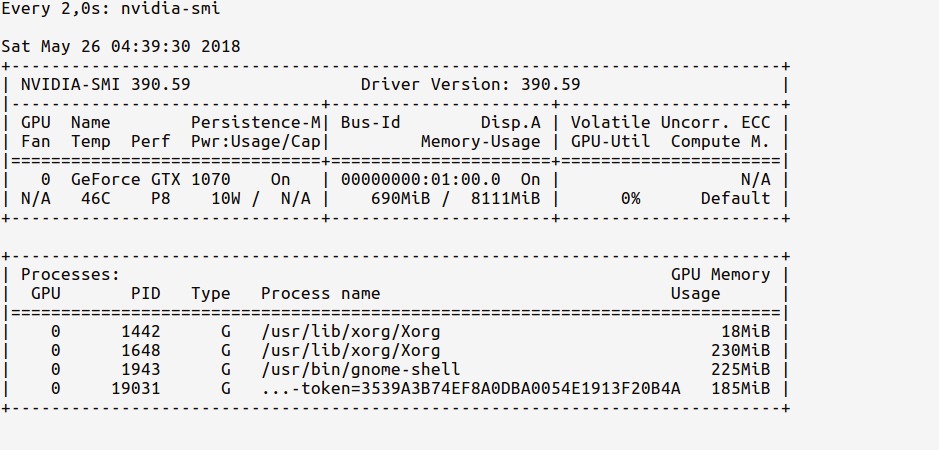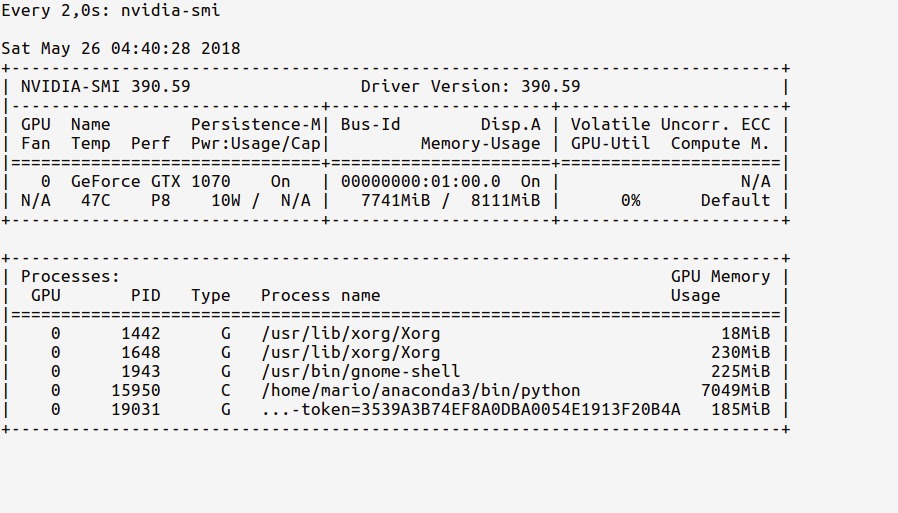问题描述
我已经使用ubuntu的内置apt cuda安装的第二个答案here在我的ubuntu 16.04中安装了tensorflow。
现在我的问题是我该如何测试tensorflow是否真的在使用gpu?我有一个gtx 960m gpu。当我import tensorflow这是输出
I tensorflow/stream_executor/dso_loader.cc:105] successfully opened CUDA library libcublas.so locally
I tensorflow/stream_executor/dso_loader.cc:105] successfully opened CUDA library libcudnn.so locally
I tensorflow/stream_executor/dso_loader.cc:105] successfully opened CUDA library libcufft.so locally
I tensorflow/stream_executor/dso_loader.cc:105] successfully opened CUDA library libcuda.so.1 locally
I tensorflow/stream_executor/dso_loader.cc:105] successfully opened CUDA library libcurand.so locally
这个输出足以检查tensorflow是否正在使用gpu吗?
最佳方法
不,我认为“开放式CUDA库”不足以说明问题,因为图形的不同节点可能位于不同的设备上。
要找出使用哪个设备,您可以启用日志设备放置,如下所示:
sess = tf.Session(config=tf.ConfigProto(log_device_placement=True))
检查您的控制台是否有这种类型的输出。

次佳方法
除了使用其他答案以及官方TensorFlow documentation中概述的sess = tf.Session(config=tf.ConfigProto(log_device_placement=True))之外,您还可以尝试将计算分配给gpu,看看是否有错误。
import tensorflow as tf
with tf.device('/gpu:0'):
a = tf.constant([1.0, 2.0, 3.0, 4.0, 5.0, 6.0], shape=[2, 3], name='a')
b = tf.constant([1.0, 2.0, 3.0, 4.0, 5.0, 6.0], shape=[3, 2], name='b')
c = tf.matmul(a, b)
with tf.Session() as sess:
print (sess.run(c))
这里
-
“/cpu:0″:您计算机的CPU。
-
“/gpu:0″:计算机的GPU(如果有)。
如果您有GPU并可以使用它,则将看到结果。否则,您将看到堆栈跟踪较长的错误。最后,您将获得以下内容:
Cannot assign a device to node ‘MatMul’: Could not satisfy explicit device specification ‘/device:GPU:0’ because no devices matching that specification are registered in this process
最近,一些有用的功能出现在TF中:
-
tf.test.is_gpu_available告知GPU是否可用
-
tf.test.gpu_device_name返回gpu设备的名称
您还可以在会话中检查可用设备:
with tf.Session() as sess:
devices = sess.list_devices()
devices将为您返回类似
[_DeviceAttributes(/job:tpu_worker/replica:0/task:0/device:CPU:0, CPU, -1, 4670268618893924978),
_DeviceAttributes(/job:tpu_worker/replica:0/task:0/device:XLA_CPU:0, XLA_CPU, 17179869184, 6127825144471676437),
_DeviceAttributes(/job:tpu_worker/replica:0/task:0/device:XLA_GPU:0, XLA_GPU, 17179869184, 16148453971365832732),
_DeviceAttributes(/job:tpu_worker/replica:0/task:0/device:TPU:0, TPU, 17179869184, 10003582050679337480),
_DeviceAttributes(/job:tpu_worker/replica:0/task:0/device:TPU:1, TPU, 17179869184, 5678397037036584928)
第三种方法
以下代码段应为您提供所有可用于tensorflow的设备。
from tensorflow.python.client import device_lib
print(device_lib.list_local_devices())
Sample Output
[name: “/cpu:0” device_type: “CPU” memory_limit: 268435456 locality { } incarnation: 4402277519343584096,
name: “/gpu:0” device_type: “GPU” memory_limit: 6772842168 locality { bus_id: 1 } incarnation: 7471795903849088328 physical_device_desc: “device: 0, name: GeForce GTX 1070, pci bus id: 0000:05:00.0” ]
第四种方法
我认为有一个更简单的方法可以实现这一目标。
import tensorflow as tf
if tf.test.gpu_device_name():
print('Default GPU Device: {}'.format(tf.test.gpu_device_name()))
else:
print("Please install GPU version of TF")
它通常打印像
Default GPU Device: /device:GPU:0
在我看来,这比那些冗长的日志更容易。
第五种方法
这是否可以确认使用GPU进行训练同时进行tensorflow吗?
码
sess = tf.Session(config=tf.ConfigProto(log_device_placement=True))
输出量
I tensorflow/core/common_runtime/gpu/gpu_device.cc:885] Found device 0 with properties:
name: GeForce GT 730
major: 3 minor: 5 memoryClockRate (GHz) 0.9015
pciBusID 0000:01:00.0
Total memory: 1.98GiB
Free memory: 1.72GiB
I tensorflow/core/common_runtime/gpu/gpu_device.cc:906] DMA: 0
I tensorflow/core/common_runtime/gpu/gpu_device.cc:916] 0: Y
I tensorflow/core/common_runtime/gpu/gpu_device.cc:975] Creating TensorFlow device (/gpu:0) -> (device: 0, name: GeForce GT 730, pci bus id: 0000:01:00.0)
Device mapping:
/job:localhost/replica:0/task:0/gpu:0 -> device: 0, name: GeForce GT 730, pci bus id: 0000:01:00.0
I tensorflow/core/common_runtime/direct_session.cc:255] Device mapping:
/job:localhost/replica:0/task:0/gpu:0 -> device: 0, name: GeForce GT 730, pci bus id: 0000:01:00.0
第六种方法
Tensorflow 2.0
从tensorflow 2.0开始,不再使用会话。测试GPU功能的一种仍然有效的方法是:
import tensorflow as tf
assert tf.test.is_gpu_available()
assert tf.test.is_built_with_cuda()
如果出现错误,则需要检查安装。
第七种方法
除了其他答案,以下内容还应帮助您确保您的tensorflow版本包括GPU支持。
import tensorflow as tf
print(tf.test.is_built_with_cuda())
第八种方法
这应该给出可用于Tensorflow的设备列表(在Py-3.6下):
tf = tf.Session(config=tf.ConfigProto(log_device_placement=True))
tf.list_devices()
# _DeviceAttributes(/job:localhost/replica:0/task:0/device:CPU:0, CPU, 268435456)
第九种方法
我更喜欢使用nvidia-smi来监视GPU使用情况。如果在开始编程时它显著上升,则表明您的张量流正在使用GPU。
第十种方法
好的,首先从终端启动ipython shell和import TensorFlow
$ ipython --pylab
Python 3.6.5 |Anaconda custom (64-bit)| (default, Apr 29 2018, 16:14:56)
Type 'copyright', 'credits' or 'license' for more information
IPython 6.4.0 -- An enhanced Interactive Python. Type '?' for help.
Using matplotlib backend: Qt5Agg
In [1]: import tensorflow as tf
现在,我们可以使用以下命令查看GPU内存使用情况:
# realtime update for every 2s
$ watch -n 2 nvidia-smi
由于我们只有import修改过TensorFlow,但尚未使用任何GPU,因此使用情况统计信息为:

观察一下GPU内存的使用量是如何非常少(〜200MB)的。
现在,让我们在代码中加载GPU。如tf documentation中所示,执行以下操作:
In [2]: sess = tf.Session(config=tf.ConfigProto(log_device_placement=True))
现在, watch 统计信息应显示更新的GPU使用情况内存,如下所示:

从ipython shell观察我们的Python进程如何使用7.7GB的GPU内存。
附言您可以在代码运行时继续观看这些统计信息,以了解GPU的使用强度。
